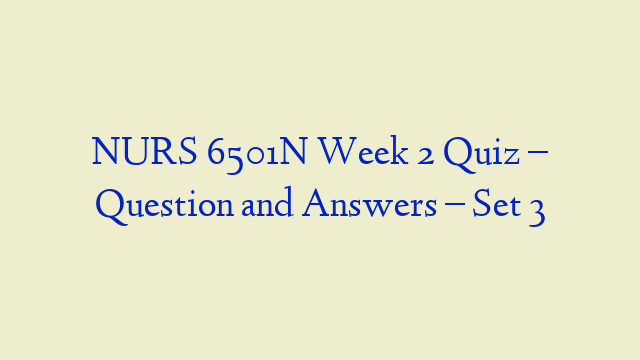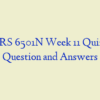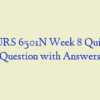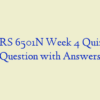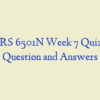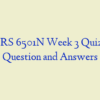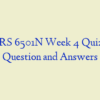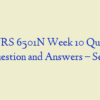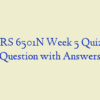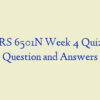Description
NURS 6501N Week 2 Quiz – Question and Answers
- A 42-year-old female presents with raised red lesions with a brownish scale. She was diagnosed with discoid lupus erythematosus. A clinician recalls this disorder is related to:
- What common symptom should be assessed in individuals with immunodeficiency?
- A 54-year-old male was recently diagnosed with rheumatoid arthritis (RA). Which of the following is the expected treatment of choice?
- A 30-year-old female complains of fatigue, arthritis, rash, and changes in urine color. Laboratory testing reveals anemia, lymphopenia, and kidney inflammation. Assuming a diagnosis of SLE, which of the following is also likely to be present?
- A 5-year-old male is diagnosed with tinea corporis following development of lesions on the non-hairy parts of his face, trunk, and limbs. A common source of this condition is a:
- When bacterial pathogens enter a patient’s body, they can defend themselves from an immune response by:
- A 5-year-old female takes a hike through the woods during a school field trip. Upon returning home, she hugs her father, and he later develops poison ivy. Which of the following immune reactions is he experiencing?
- After studying about fungi, which information indicates a correct understanding of fungi? Fungi causing deep or systemic infections:
- The nurse would expect the occurrence of scabies to occur more commonly among children who:
- Tinea corporis (ringworm) is a _____ infection of the skin.
- A 4-month-old female develops white spots and shallow ulcers in her mouth. Her pediatrician diagnoses her with thrush. This condition is caused by:
- Rubella, rubeola, and roseola are common communicable diseases caused by _____ infection.
- For a patient with candidiasis, which factor will exacerbate the condition?
- A 4-month-old female is diagnosed with atopic dermatitis (AD). Which of the following assessment findings by the nurse will most likely support this diagnosis?
- When trying to distinguish between an infectious disease and noninfectious disease, what is the hallmark symptom for most infectious diseases?
- A 45-year-old male presents with persistent, severe stomach pain. Testing reveals a peptic ulcer. Further laboratory tests reveal the presence of Helicobacter pylori. Which of the following is of concern for this patient?
- A 30-year-old male was diagnosed with HIV. Which of the following treatments would be most effective?
- After teaching about stress, which information indicates a correct understanding of stress? nurs 6501n week 2
- A 50-year-old female experience decreased blood pressure, decreased oxygen delivery, cardiovascular shock, and subsequent death. A complication of endotoxic shock is suspected. Which of the following is the most likely cause?
- Exhaustion occurs if the stress continues and _____ is not successful.
- Which of the following hormones activates adrenergic receptors?
- During inflammation, the liver is stimulated to release plasma proteins, collectively known as:
- A 65-year-old female is diagnosed with metastatic breast cancer. She has developed muscle wasting. Which of the following substances would be produced in large quantities to eliminate the tumor cells and cause muscle wasting?
- When does a patient ask the nurse what hypersensitivity is, how should the nurse respond? Hypersensitivity is best defined as:
- A 35-year-old male is diagnosed with lobar pneumonia (lung infection). Which of the following exudates would be present in highest concentration at the site of this advanced inflammatory response?
- A 20-year-old male shoots his hand with a nail gun while replacing roofing shingles. Which of the following cell types would be the first to aid in killing bacteria to prevent infection in his hand?
- An infant develops a fever secondary to a bacterial infection. Which of the following most likely triggered the fever?
- A 30-year-old female presents to her primary care provider reporting fatigue, excessive sweating, and increased appetite. Physical examination reveals protruding eyes, and laboratory testing reveals hyperthyroidism secondary to autoantibody production. This disorder falls into the category of type _____ hypersensitivity.
- Which of the following individuals would be at greatest risk for an opportunistic infection?
- A patient presents with poison ivy on the extremities, face, and buttocks. This condition is an example of:
- A child fell off the swing and scraped the right knee. The injured area becomes painful. What else will the nurse observe upon assessment?
- Which of the following patients would be at greatest risk for basal cell carcinoma? nurs 6501n week 2
- A 30-year-old female is diagnosed with cancer. Testing reveals that the cancer cells have spread to local lymph nodes. A nurse realizes this cancer would be documented as stage:
- While planning care for children with cancer, which information should the nurse remember? Most childhood cancers originate from the:
- A patient has a tissue growth that was diagnosed as cancer. Which of the following terms best describes this growth?
- When the maternal immune system becomes sensitized against antigens expressed by the fetus, what type of immune reaction occurs?
- Stress induces sympathetic stimulation of the adrenal medulla. This causes the secretion of catecholamines, which include:
- Which patient will develop active immunity? A patient who:
- A 30-year-old male is having difficulty breathing and has been spitting blood. He reports that he began experiencing this reaction after cleaning his pigeons’ cages. Testing reveals he is suffering from allergic alveolitis. Which of the following is he experiencing? nurs 6501n week 2
- When a patient presents at the emergency department for an allergic reaction, the nurse recognizes the most severe consequence of a type I hypersensitivity reaction is:
